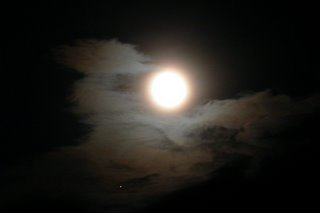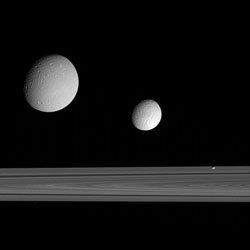
Image Credit: Beth Katz, http://www.spacew.com/gallery/image005097.html, katz@cs.millersville.edu
Oh, my my. The moon completes its journey from crescent as it passed Venus to near full now at Mars.... HIgh overhead in the middle of the night, the brilliant moon sails past bright clouds, the carnelian shimmer of Mars hanging directly underneath, the two travelling together across the sky. Patches of light clouds, shining white in a full moon sky sparse with stars, give the two exiherating, illusory bursts of speed as they pass by. Just as I walk outside, the Moon speeds away from the shadowed edge of one, while Mars shines through then it, too, finds freedom sprinting into the dark sky.
This round moon a mirror for the sun, nearly directly opposite it in the sky, now far beneath our feet, noontime in India. As always at the days around full moon, we look past it into deep space, our backs to the solar heart. Mars out there too, and Saturn rising high now in the east, somewhat ahead of us as we begin to catch it on our inside orbit, seemingly so distant (far beyond Mars, the asteroids, and even great Jupiter, only the far distant outer planets beyond it). And winter's stellar glory also drifing across the southern sky now as we enter the wee hours: Orion, his lines and angles, brilliant stars of blue, red, and white, trailed by his trusty Dog Star, Sirius, close to directly behind us in the great turning body of the Milky Way. Hard to see tonight, the winter wash of galactic arms erased by the moon, but in coming months during the dark of the moon, this will come clear again.
On and on, then, this annual turning to look out of the galaxy's disc, as in summer we gaze into its heart. On, too, the monthly guiding gaze of the moon, reminding us of our orientation to the sun, and so also to space.
And again as always, these mental pictures, these classroom models of the sky come alive a fraction more, my body steps a tad more boldly into the body of the solar system, and imagines a sliver more vividly the body of the galaxy, which is indeed larger than the infinity I can find a way to hold. So far.
The sky opens wide at night.








